
The Supermarine Attacker is a British single-seat naval jet fighter designed and produced by aircraft manufacturer Supermarine for the Royal Navy's Fleet Air Arm (FAA). It was the first jet fighter to enter operational service with the FAA.

The Vickers Viking was a British single-engine amphibious aircraft designed for military use shortly after World War I. Later versions of the aircraft were known as the Vickers Vulture and Vickers Vanellus.
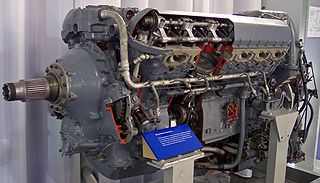
The Rolls-Royce Griffon is a British 37-litre capacity, 60-degree V-12, liquid-cooled aero engine designed and built by Rolls-Royce Limited. In keeping with company convention, the Griffon was named after a bird of prey, in this case the griffon vulture.

The Supermarine Spiteful was a British fighter aircraft designed by Supermarine during the Second World War as a successor to the Spitfire. Powered by a Rolls-Royce Griffon engine, it had a radical new wing design to allow safe operations at higher speeds and incorporating inwards-retracting undercarriage. Other changes included a larger fin to improve the marginal stability of Griffon Spitfires. Development of the wing was formalised by Air Ministry specification F.1/43; as well as a new aircraft, there was an expectation the wing could be used as a replacement for the elliptical wing on Spitfire production.
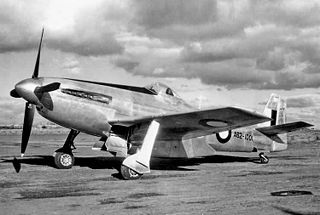
The CAC CA-15, was an Australian propeller-driven fighter aircraft designed by the Commonwealth Aircraft Corporation (CAC) during World War II. Due to protracted development, the project was not completed until after the war, and was cancelled after flight testing, when the advent of jet aircraft was imminent.
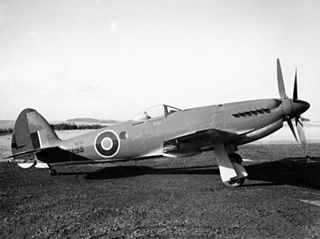
The Supermarine Seafang was a British Rolls-Royce Griffon–engined fighter aircraft designed by Supermarine to Air Ministry specification N.5/45 for naval use. It was based on the Spiteful, which was a development of Supermarine's Griffon-engined Spitfire aircraft. By that time the Spitfire was a 10-year-old design in a period of rapid technical development in aviation. The Seafang was outmoded by jet aircraft, and only 18 were built.

The British Martin-Baker MB 5 was the ultimate development of a series of prototype fighter aircraft built during the Second World War. Neither the MB 5 nor its predecessors ever entered production, despite what test pilots described as excellent performance.

The Supermarine Scapa was a British general reconnaissance flying boat built by Supermarine that was used by the Royal Air Force between 1935 and 1939. It was developed from the Southampton and formed the basis of the Supermarine Stranraer.

The Supermarine Seagull was a flying boat produced by the British aircraft manufacturer Supermarine. It was developed by Supermarine's chief designer R.J. Mitchell from the experimental Supermarine Seal II.
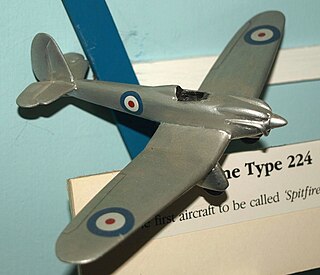
The Supermarine Type 224 was a British gull-wing monoplane fighter aircraft designed by R.J. Mitchell at Supermarine in response to Air Ministry Specification F.7/30, which sought to introduce a new fighter to succeed the Gloster Gauntlet. The Type 224 was powered by a Rolls-Royce Goshawk engine, which used an experimental evaporative cooling system.

The Supermarine Type 322 was a prototype British carrier-borne torpedo, dive bomber and reconnaissance aircraft of the Second World War. A single-engined monoplane, it was unsuccessful, with only two examples being built. The Fairey Barracuda, built to the same specification, would fill this role.

The Supermarine Seamew was a British twin engined amphibious aircraft built by Supermarine at their works in Woolston, Southampton. It was intended as a small, shipborne reconnaissance aircraft. It was designed in 1925–1927 by R. J. Mitchell to meet the Air Ministry's specification 29/24. It was the first aeroplane built by Supermarine to incorporate metal in the construction; two machines were built. Mitchell planned a civilian version of the aircraft, to accommodate up to six passengers.

The Supermarine Swan was a 1920s British commercial biplane flying boat designed by R.J. Mitchell. A single machine was built by Supermarine at their works at Woolston, Southampton. The world's first twin-engine amphibian aircraft, it was the precursor to the Supermarine Southampton.

The Supermarine Sea Eagle was a British, passenger–carrying, amphibious flying boat. It was designed and built by the Supermarine Aviation Works for its subsidiary, the British Marine Air Navigation Co Ltd, to be used on their cross-channel route between Southampton, the Channel Islands and France.

The Supermarine Commercial Amphibian was a passenger-carrying flying boat. The first aircraft to be designed by Supermarine's Reginald Mitchell, it was built at the company's works at Woolston, Southampton, for an Air Ministry competition that took place during September 1920. Based on the Supermarine Channel, the Amphibian was a biplane flying boat with a single engine, a wooden hull, unequal wingspans and a 350 horsepower (260 kW) Rolls-Royce Eagle engine. The pilot sat in an open cockpit behind two passengers.

The Supermarine Seal II was a British flying boat developed by Supermarine after it secured a British Air Ministry order for a prototype three-seater fleet spotter amphibian. The prototype, which had to be capable of landing on Royal Air Force (RAF) aircraft carriers, was designed by Supermarine's R.J. Mitchell, who incorporated suggestions made after the Supermarine Commercial Amphibian achieved second place after it was entered for an Air Ministry competition in 1920.

The Rolls-Royce Griffon engine was designed in answer to Royal Navy specifications for an engine capable of generating good power at low altitudes. Concepts for adapting the Spitfire to take the new engine had begun as far back as October 1939; Joseph Smith felt that "The good big 'un will eventually beat the good little 'un." and Ernest Hives of Rolls-Royce thought that the Griffon would be "a second power string for the Spitfire". The first of the Griffon-engined Spitfires flew on 27 November 1941.

The de Havilland DH.27 Derby was a large single-engined biplane designed to a heavy day bomber Air Ministry specification. It did not reach production.
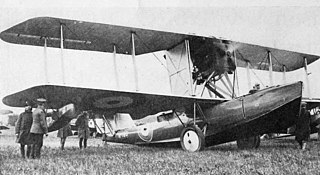
The Supermarine Sheldrake was a British amphibian biplane flying boat developed by Supermarine from the Supermarine Seagull with a revised hull. It was powered by a Napier Lion engine mounted between the wings driving a four-bladed propeller. Only one Sheldrake, serial number N180, was built.
The Supermarine Type 179 "Giant" was a British monoplane flying boat developed by Supermarine but cancelled before completion.



















